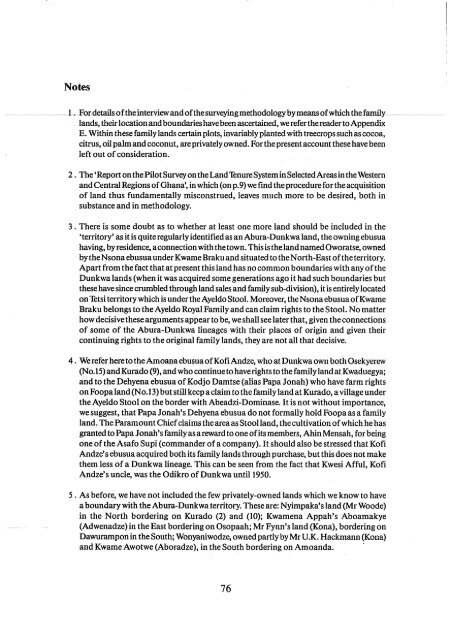Create successful ePaper yourself
Turn your PDF publications into a flip-book with our unique Google optimized e-Paper software.
Notes<br />
1 .. For details of the interview and ofthesurveying methodology by means of which the family.<br />
lands, their location and boundaries have been ascertained, we refer the reader to Appendix<br />
E. Within these family lands certain plots, invariably planted with treecrops such as cocoa,<br />
citrus, oil palm and coconut, are privately owned. For the present account these have been<br />
left out of consideration.<br />
2. The 'Report on the Pilot Survey on the Land Tenure System in Selected Areas in the Western<br />
and Central Regions of Ghana', in which (on p.9) we find the procedure for the acquisition<br />
of land thus fundamentally misconstrued, leaves much more to be desired, both in<br />
substance and in methodology.<br />
3 . There is some doubt as to whether at least one more land should be included in the<br />
'territory' as it is quite regularly identified as an Abura-Dunkwa land, the owning ebusua<br />
having, by residence, aconnection with the town. This is the land named Oworatse, owned<br />
by the Nsona ebusua under K warne Braku and situated to the North-East of the territory.<br />
Apart from the fact that at present this land has no common boundaries with any of the<br />
Dunkwa lands (when it was acquired some generations ago it had such boundaries but<br />
these have since crumbled through land sales and family sub-division), it is entirely located<br />
on Tetsi territory which is under the Ayeldo Stool. Moreover, the Nsona ebusua of Kwame<br />
Braku belongs to the Ayeldo Royal Family and can claim rights to the Stool. No matter<br />
how decisive these arguments appear to be, we shall see later that, given the connections<br />
of some of the Abura-Dunkwa lineages with their places of origin and given their<br />
continuing rights to the original family lands, they are not all that decisive.<br />
4. We refer here to the Amoana ebusua ofKofi Andze, who at Dunkwa own both Osekyerew<br />
(No.15) and Kurado (9), and who continue to have rights to the family land at Kwaduegya;<br />
and to the Dehyena ebusua of Kodjo Damtse (alias Papa Jonah) who have farm rights<br />
on Foopa land (N 0.13) but still keep a claim to the family land at Kurado, a village under<br />
the Ayeldo Stool on the border with Abeadzi-Dominase. It is not without importance,<br />
we suggest, that Papa Jonah's Dehyena ebusua do not formally hold Foopa as a family<br />
land. The Paramount Chief claims the area as Stool land, the cultivation of which he has<br />
granted to Papa Jonah's family as a reward to one ofits members, Ahin Mensah, for being<br />
one of the Asafo Supi (commander of a company). It should also be stressed that Kofi<br />
Andze's ebusua acquired both its family lands through purchase, but this does not make<br />
them less of a Dunkwa lineage. This can be seen from the fact that Kwesi Afful, Kofi<br />
Andze's uncle, was the Odikro of Dunkwa until 1950.<br />
5 . As before, we have not included the few privately-owned lands which we know to have<br />
a boundary with the Abura-Dunkwa territory. These are: Nyimpaka's land (Mr Woode)<br />
in the North bordering on Kurado (2) and (10); Kwamena Appah's Aboamakye<br />
(Adwenadze) in the East bordering on Osopaah; Mr Fynn's land (Kona), bordering on<br />
Dawurampon in the South; Wonyaniwodze, owned partly by Mr U.K. Hackmann (Kona)<br />
and Kwame Awotwe (Aboradze), in the South bordering on Amoanda. .<br />
76
















